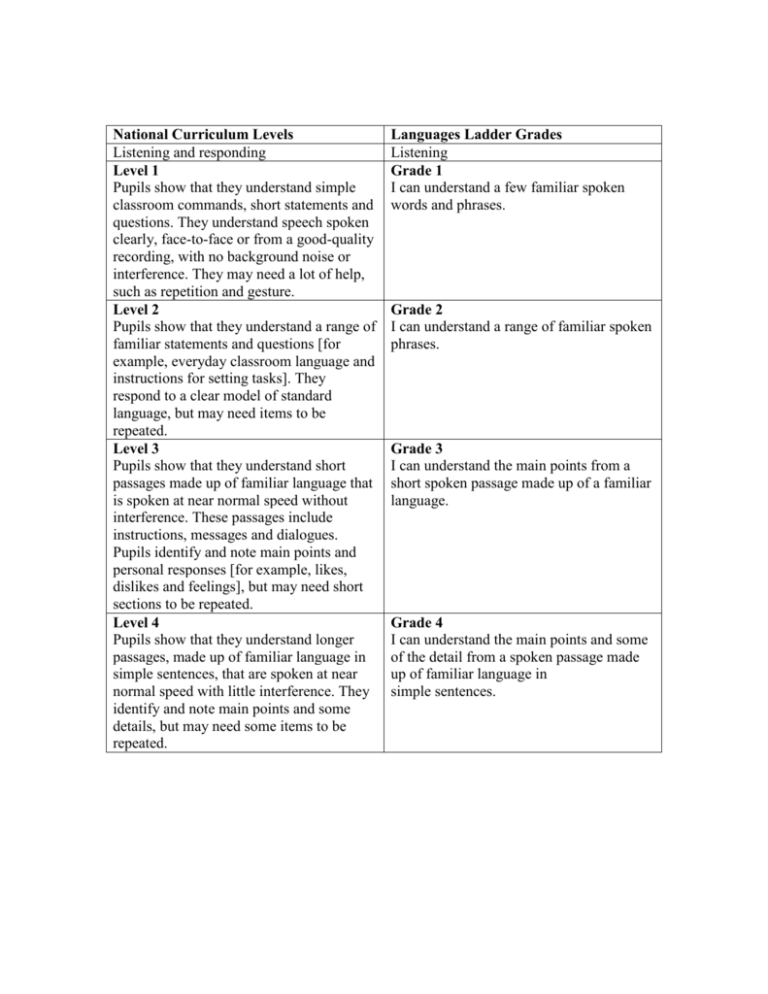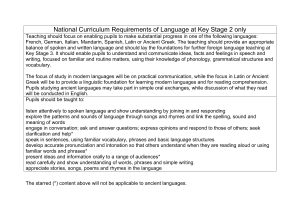National Curriculum Levels
advertisement

National Curriculum Levels Listening and responding Level 1 Pupils show that they understand simple classroom commands, short statements and questions. They understand speech spoken clearly, face-to-face or from a good-quality recording, with no background noise or interference. They may need a lot of help, such as repetition and gesture. Level 2 Pupils show that they understand a range of familiar statements and questions [for example, everyday classroom language and instructions for setting tasks]. They respond to a clear model of standard language, but may need items to be repeated. Level 3 Pupils show that they understand short passages made up of familiar language that is spoken at near normal speed without interference. These passages include instructions, messages and dialogues. Pupils identify and note main points and personal responses [for example, likes, dislikes and feelings], but may need short sections to be repeated. Level 4 Pupils show that they understand longer passages, made up of familiar language in simple sentences, that are spoken at near normal speed with little interference. They identify and note main points and some details, but may need some items to be repeated. Languages Ladder Grades Listening Grade 1 I can understand a few familiar spoken words and phrases. Grade 2 I can understand a range of familiar spoken phrases. Grade 3 I can understand the main points from a short spoken passage made up of a familiar language. Grade 4 I can understand the main points and some of the detail from a spoken passage made up of familiar language in simple sentences. National Curriculum Levels Speaking Level 1 Pupils respond briefly, with single words or short phrases, to what they see and hear. Their pronunciation may be approximate, and they may need considerable support from a spoken model and from visual cues. Level 2 Pupils give short, simple responses to what they see and hear. They name and describe people, places and objects. They use set phrases [for example, to ask for help and permission]. Their pronunciation may still be approximate and the delivery hesitant, but their meaning is clear. Level 3 Pupils take part in brief prepared tasks of at least two or three exchanges, using visual or other cues to help them initiate and respond. They use short phrases to express personal responses [for example, likes, dislikes and feelings]. Although they use mainly memorised language, they occasionally substitute items of vocabulary to vary questions or statements. Level 4 Pupils take part in simple structured conversations of at least three or four exchanges, supported by visual or other cues. They are beginning to use their knowledge of grammar to adapt and substitute single words and phrases. Their pronunciation is generally accurate and they show some consistency in their intonation. Languages Ladder Grades Speaking Grade 1 I can say and repeat single words and short simple phrases. Grade 2 I can answer simple questions and give basic information. Grade 3 I can ask and answer simple questions and talk about my interests. Grade 4 I can take part in a simple conversation and I can express my opinions. National Curriculum Levels Reading and responding Level 1 Pupils show that they understand single words presented in clear script in a familiar context. They may need visual cues. Level 2 Pupils show that they understand short phrases presented in a familiar context. They match sound to print by reading aloud single familiar words and phrases. They use books or glossaries to find out the meanings of new words. Level 3 Pupils show that they understand short texts and dialogues, made up of familiar language, printed in books or wordprocessed. They identify and note main points and personal responses [for example, likes, dislikes and feelings]. They are beginning to read independently, selecting simple texts and using a bilingual dictionary or glossary to look up new words. Level 4 Pupils show that they understand short stories and factual texts, printed or clearly handwritten. They identify and note main points and some details. When reading on their own, as well as using a bilingual dictionary or glossary, they are beginning to use context to work out what unfamiliar words mean. Languages Ladder Grades Reading Grade 1 I can recognise and read out a few familiar words and phrases. Grade 2 I can understand and read out familiar written phrases. Grade 3 I can understand the main points from a short written text in clear printed script. Grade 4 I can understand the main points and some of the detail from short written texts in familiar contexts. National Curriculum Levels Writing Level 1 Pupils copy single familiar words correctly. They label items and select appropriate words to complete short phrases or sentences. Level 2 Pupils copy familiar short phrases correctly. They write or word-process items [for example, simple signs and instructions] and set phrases used regularly in class. When they write familiar words from memory their spelling may be approximate. Level 3 Pupils write two or three short sentences on familiar topics, using aids [for example, textbooks, wall charts and their own written work]. They express personal responses [for example, likes, dislikes and feelings]. They write short phrases from memory and their spelling is readily understandable. Level 4 Pupils write individual paragraphs of about three or four simple sentences, drawing largely on memorised language. They are beginning to use their knowledge of grammar to adapt and substitute individual words and set phrases. They are beginning to use dictionaries or glossaries to check words they have learnt. Languages Ladder Grades Writing Grade 1 I can write or copy simple words or symbols correctly. Grade 2 I can write one or two short sentences to a model and fill in the words on a simple form. Grade 3 I can write a few short sentences with support, using expressions which I have already learnt. Grade 4 I can write a short text on a familiar topic, adapting language which I have already learnt.


![afl_mat[1]](http://s2.studylib.net/store/data/005387843_1-8371eaaba182de7da429cb4369cd28fc-300x300.png)





